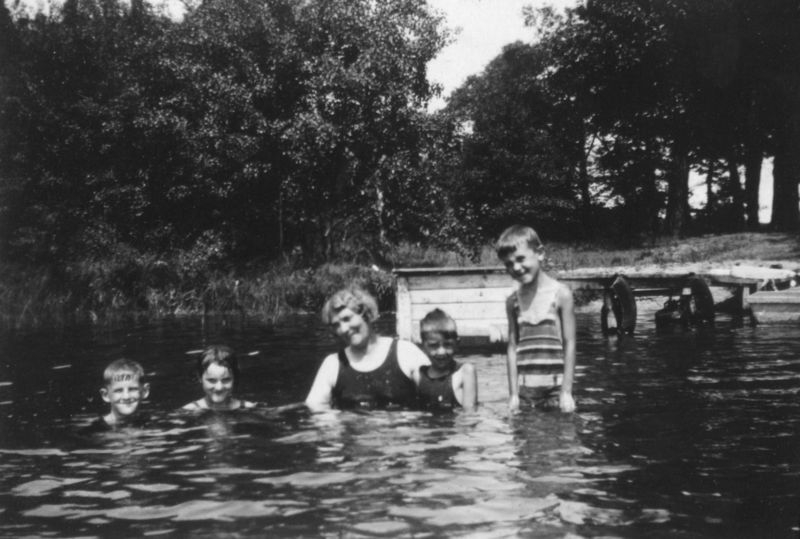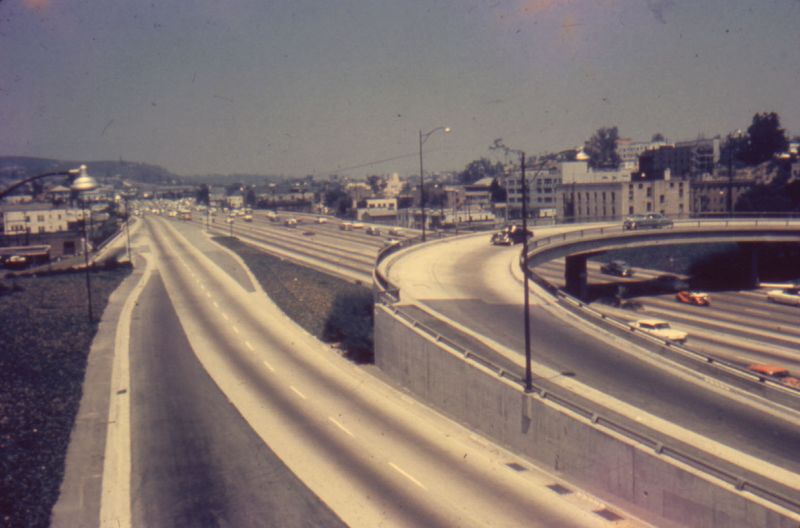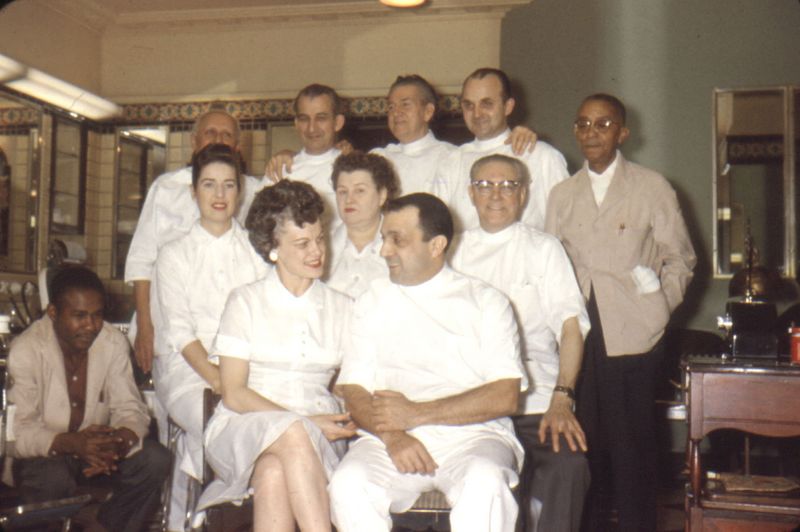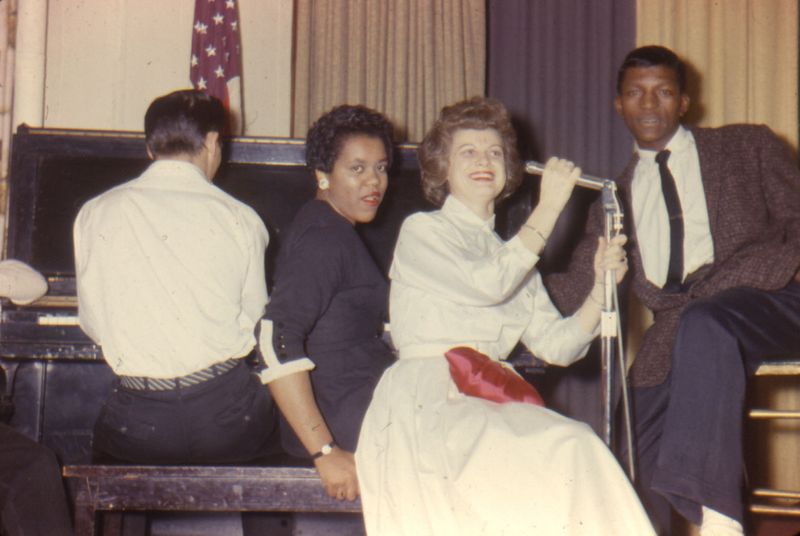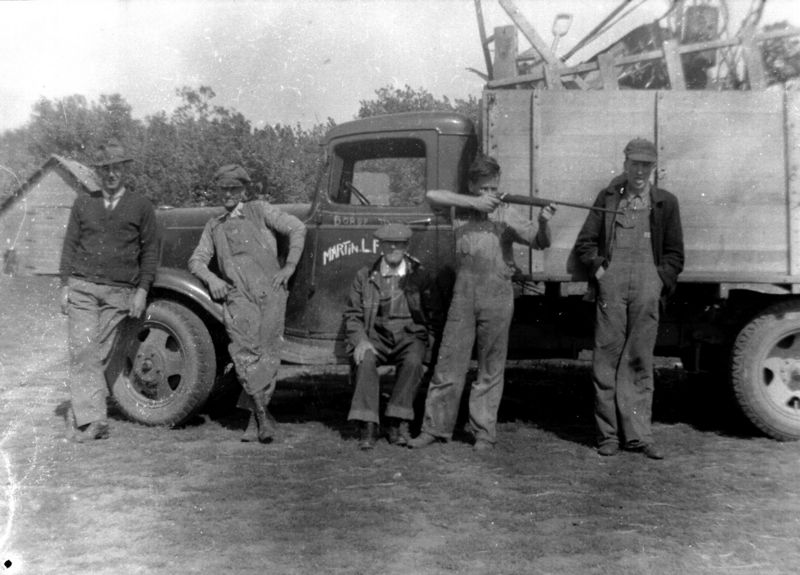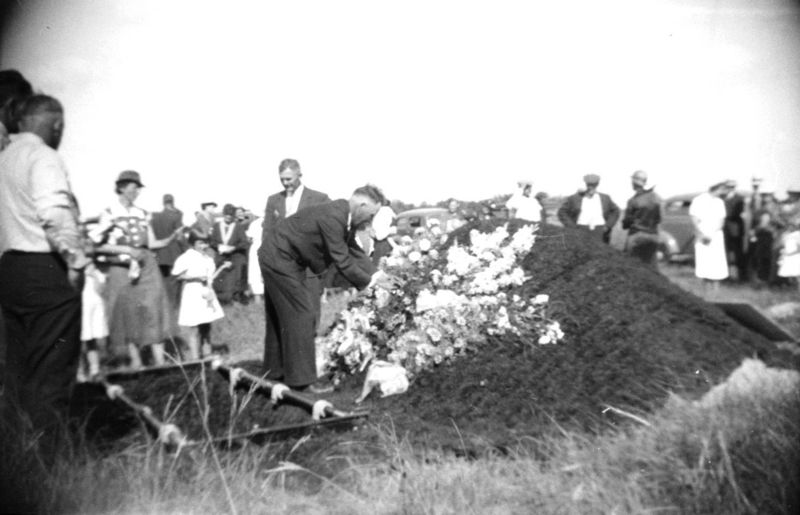 |

| |
|
|  |
Trompe l'Oeil At The Pfister
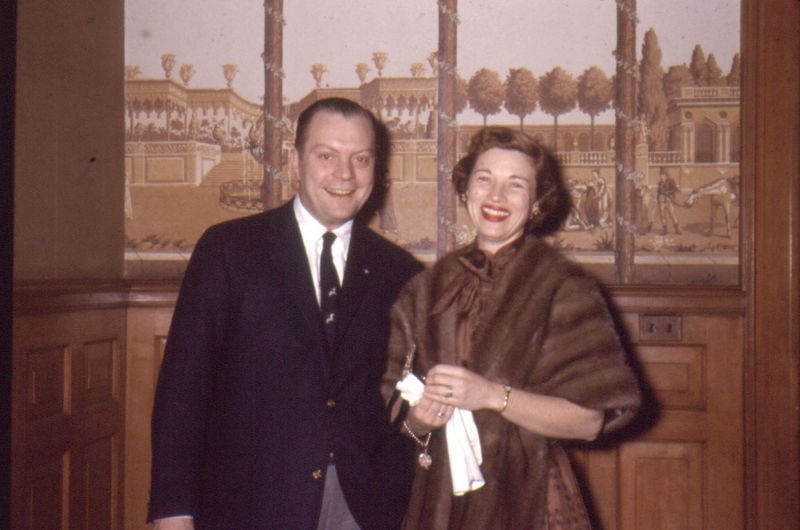 Say 'hi' to Larry & Ruth Smith, frequenters of the Pfister Hotel. This was taken in February 1957, along with several other photos I've uploaded. This photo has the best view of the trompe l'oeil wallpaper in the Pfister. A different wallpaper is visible in other photos, but this the best view of any of them. And it is wallpaper - you can see the seam just over the lady's right shoulder, and note how the wall in the distance doesn't line up between. The wallpaper artist used the ivy-wrapped columns to both hide the seam and create a 'break' to obscure varying views put side-by-side; my guess is that this paper (probably spendy) was sold with numerous vignettes, intended to be randomly juxtaposed for a more natural look. It was designed to be applied with a wainscoting, to leave the view appropriately at eye-level, and was probably quite expensive at the time. The Pfister was a classy place, though -- it was worth it. Labels: 1950s, 1957, fur coat, pfister hotel, trompe l'oeil, vintage photo, wallpaper
A Sea Of Hats: Farm Foreclosure Sale
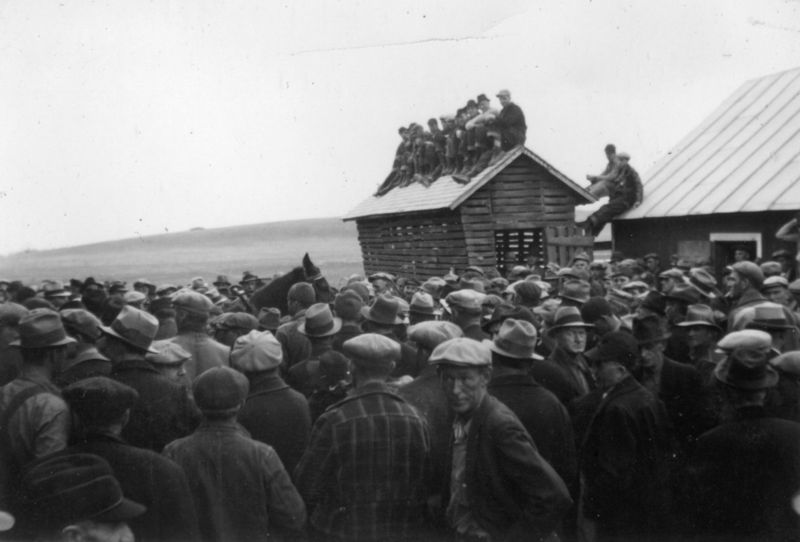 This image This image, one of two captioned "At Uncle Nick's Auction," shows a common sight around the rural USA during the 1930s. No, not just a crowd of fedoras and paperboy hats (although those were quite common, especially at the employment office or the bread lines). Farm foreclosures were driven by the Great Depression, a sluggish economy, a prewar slump due to foreign instability, and the ongoing change from a raw-materials economy to a manufacturing economy. This one appears to have been taken in 1938, after the "heyday" of foreclosures in the early 1930s. Early on, farmers protested and caused 'penny auctions' -- friends and neighbors ran off genuine bidders, and never bid more than a penny for any lot. By the late 1930s the worst of it was over, some economic reforms were starting to help, and this auction was probably handled better than frantic bank-recoveries earlier in the decade. Also: farmer's diary * iowa depression * nebraska foreclosures * remembering farm life Labels: 1930s, 1938, antique photo, farm life, wisconsin history
Church Criticism In Czech Scripture
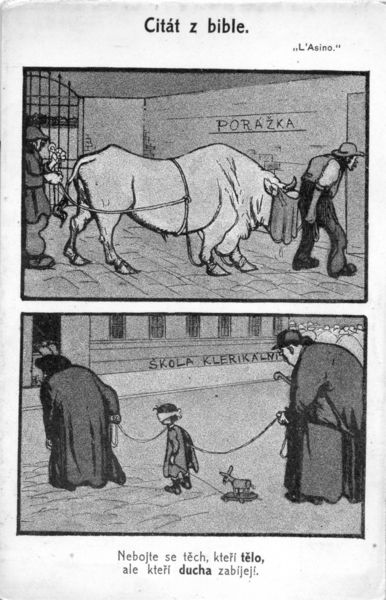 Last week's postcard Last week's postcard got a lot of attention thanks to SPS (nsfw), so here's card #2. This appears to hail from the same time-period, but isn't postmarked or dated like the previous card. The top line says, " Quotation From Scripture", and the bottom reads, " So fear those who slaughter the body and the soul." Like a bull to slaughterhouse ( porážka), a child is taken in for religious education ( škola klerikálni). The blindfold on the bull is used to keep it calm when leading it to slaughter; the child is also being taken 'blindfold to the abattoir,' oblivious to the harm approaching. Even without understanding Czech, the image is powerful without the direct accusation of destroying body and soul. The quote isn't right, though; I compared to several Czech translations available online, and the quote is similar to Matthew 10:28, which says not to fear enemies who can destroy the body, instead fear what God can do to your soul in Hell. By changing word-placement, the maker of this card accuses the clergy of making a Hell on earth for students left in their care. I've read up a bit more on what group would be so critical of the church to produce these editorial cartoons so publicly. At the time, turn-of-the-20th-century, the Freethinkers were a prominent group in Czech life, growing from Bohemia and anti-Hapsburg sentiment. The Czech regions, ruled by Austria, were made Catholic states, and popular sentiment began to turn anti-church by the mid-19th century. The Hapsburgs rule ended, and the regions gained more autonomy through the end of the 19th century. Marxism and socialism were developing as social, non-governmental movements, the Freethought movement was very popular amongst the religion-suspicious populous. These postcards were popular-sentiment status quo for the young independent, Bohemian Czech Republic. Labels: 1900s, anti-religious, czech, postcard
Where Do The Animals Live?
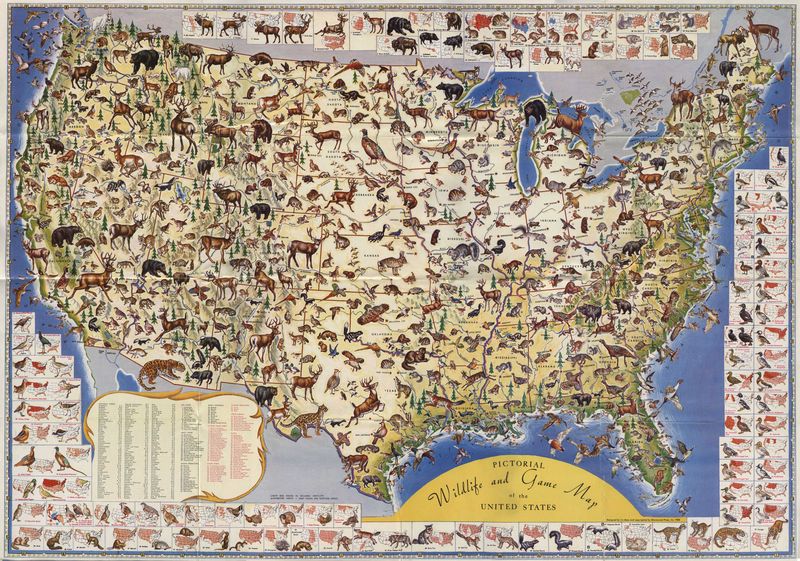 This is a " Pictorial Wildlife and Game Map" from 1956. Unlike a population map or 'Game of the States", this documents those critters we hate to have around, but really don't want to disappear. In terms of information use, the map is very cluttered, but it does an pretty job of covering migration ranges and general locations. The central map shows the general locations of a variety of animals' habitats, and around the edge we see species-specific ranges outlined in red. The hundreds of tiny animal drawings are excellent -- I did my best to make it as large as possible to get more detail for you, but hitting my webserver's limit of memory kept is smaller than I'd have liked. Still, the big version should give you a pretty good idea of who's living where. [more maps] Labels: 1950s, 1956, data visualization, habitat, information design, maps, wildlife
Howard Binford's Guide
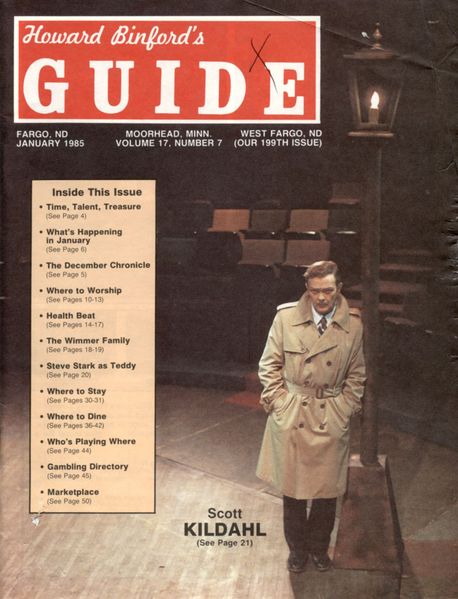 Howard Binford was a journalism instructor at Moorhead State University when he started his magazine: Howard Binford's Guide, a free publication for tourists or other non-locals providing handy lists of places to eat and sleep, who's performing in town, and other things of interest in the Fargo-Moorhead area. The magazine ran from 1968 until Binford died in 1989, with some changes throughout (as you'd expect in over 20 years of publishing), but the magazine kept its content and tone through the years. The magazine was sold to Kaye's printing in 1986, and after Binford's passing Kaye's continued publishing as "Fargo-Moorhead Magazine" -- after which they, themselves, were bought by the Fargo Forum. The magazine started in '68 by a teacher continues today through the largest regional publisher in the Red River Valley. Each Guide had a profile or interview with some local dignitary; hardly a whos-who of international fame, Binford wrote about an interesting group of local religious leaders, businessmen, regional government, and amateur performers. Labels: downtown fargo, fargophilia, howard binford's guide, magazine
Claiming Her Own Nickname
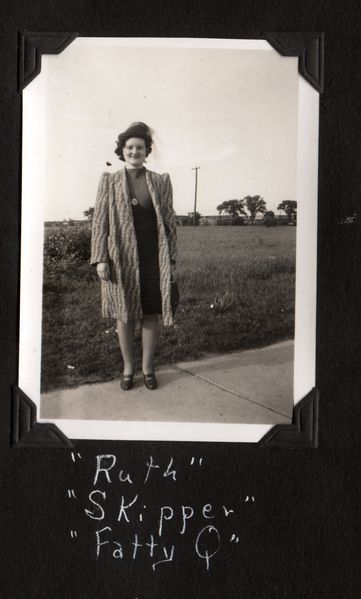 Here, to the right Here, to the right, is Ruth. She once had a photo album of her life in the late 1930s, which I've started scanning recently. On the second page of the album, she has a series of captioned photos captioned as a dramatis personae, identifying the players in her life. Her self-portrait includes several nicknames -- "Fatty Q" being one of them. While not the lithest of ingenues, Ruth isn't obese, so that might be why she's accepted the nickname without offense. The nickname of 'Skipper' is interesting, too. The two things we associate 'skipper' with -- the fat guy on Gilligan's Island, and Barbie's sister -- were decades away from Ruth's life. Captaining a boat was the main definition, although 'one who skips' could mean she either has a slight jump in her step, or maybe she prefers to avoid going to class. Either way, Ruth has two 1930s nicknames that she was proud enough to own to save it for her kids to see: I hope she was still as proud of them years later. Labels: 1930s, 1938, vintage photo, wisconsin history
Sittin' on Grandpa
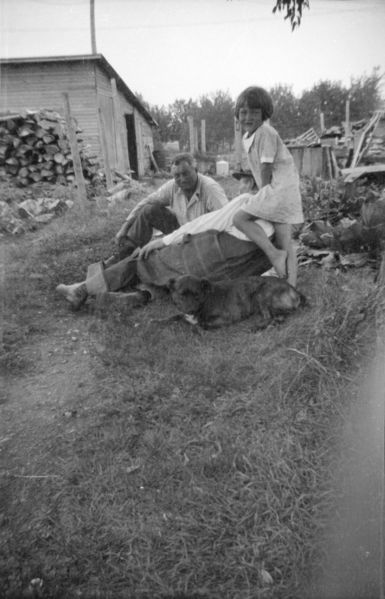 On a hot summer day, sittin' on grandpa is the funnest thing for a pixie-cut girl to do. This photo hails from the late 1930s in rural Minnesota, and is the kind of candid real-life photo you hope to see out of dozens of posed, dour pictures of family members. It's also a part of the farm photos don't usually get taken at --nobody poses in front of the junk pile for a family picture. The jungle-gym is clearly Grandpa: he looks much the same in nearly every photo, up until the 50s. The guy sitting up, I'm unsure who he might be, possibly a hired hand. As a farm kid, I remember those summer days -- "I'm bored; I should go bother Grandpa for a while." Turns out, Grandpas usually spend all day hoping the grandkids stop by to interrupt his work. Labels: 1930s, early 20th century farm photos, farm life, grandkid, grandpa
More Cranky Kids
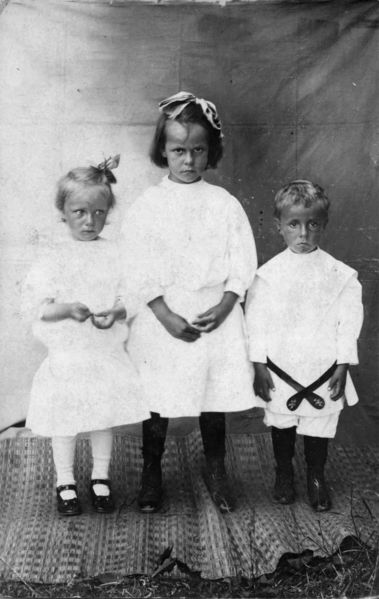 I'm not sure how these children relate to the grumps in this photo from last week, But they seem to share a venue and photographer. It's the same (or very similar) venue, a folded sheet of some sort hung as a backdrop, with a dirt floor. The kids' footing is improved by adding a reed mat on the ground for this photo, but it didn't improve the children's attitudes. Little Gunther looks like he's about to cry, and the photographer is lucky Marta can't actually start fires with her mind even though she's trying really, really hard. The style of dress is of a similar period as the previous photo, but a bit more formal: all white may signify some religious event is taking place (baptism, first communion, etc.), or it could be that their church-clothes are the nicest outfits they have to put on for a photographer. Labels: 1900s, antique photo, clothing, kids
The Fear Of Death
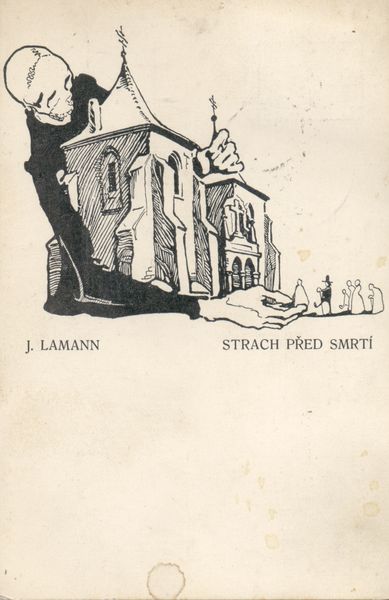 I bought a couple of these interesting postcards at a antique show recently. The drawings caught my eye, but the messages on them are a bit more striking as I've been figuring out what they say. They date from the very early 20th century -- this one from 1909 -- and they are all blatantly anti-religious, focusing on Christianity. This one doesn't directly target the church itself, but the followers. The phrase " strach před smrtî", as closely as I can translate, means " The fear of death." To believe in something solely over fear of your eternal soul, the producer of this card believes, is a poor choice for faith. I'm still researching the postcards' origins: they seem too early to be Communist, but religious opposition had many sources in that period. I should know a little more as I get to the other cards in the future. Labels: 1900s, 1909, anti-religious, czech, postcard
Laziness and the P.W.A.
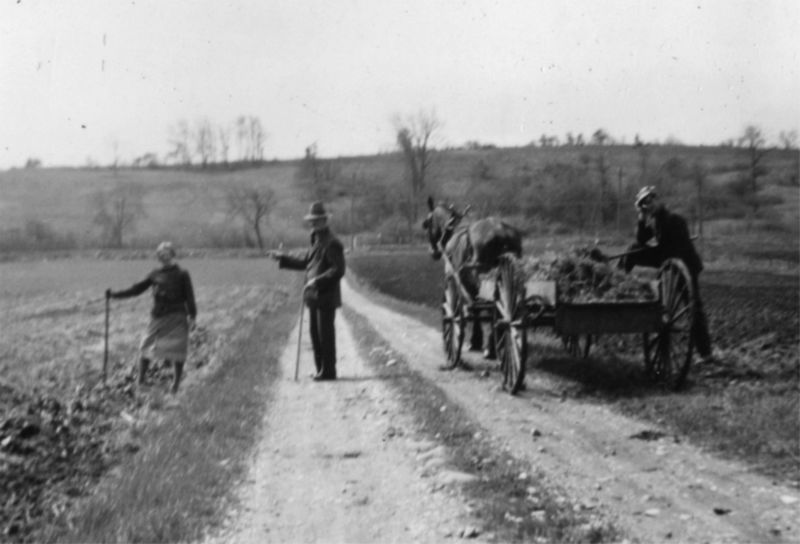 In 1933, the US government starting putting a large amount of money into public works, helping the economy, building communities, and keeping people working. The PWA, or Public Works Administration, did a lot of high-profile work, but the PWA helped communities and projects of all sizes. This picture was captioned "P.W.A. Workers" -- however, they look hardly like a PWA project. The owner of the photo album had a sense of humor; the PWA (and its relative, the WPA) had a somewhat undeserved reputation for laziness. Ms. Photographer, it seems, saw a woman in the field -- and the guys not working -- as representative of the PWA, whether or not their paychecks came from the New Deal or not. see also: the pwa *pwa thoughts * *pwa and nat'l parks * the wpa * wpa murals * wpa in georgia * wpa postersLabels: 1930s, 1938, farm life, farming, public works administration, pwa, wisconsin history, wpa
1930s Nicknames
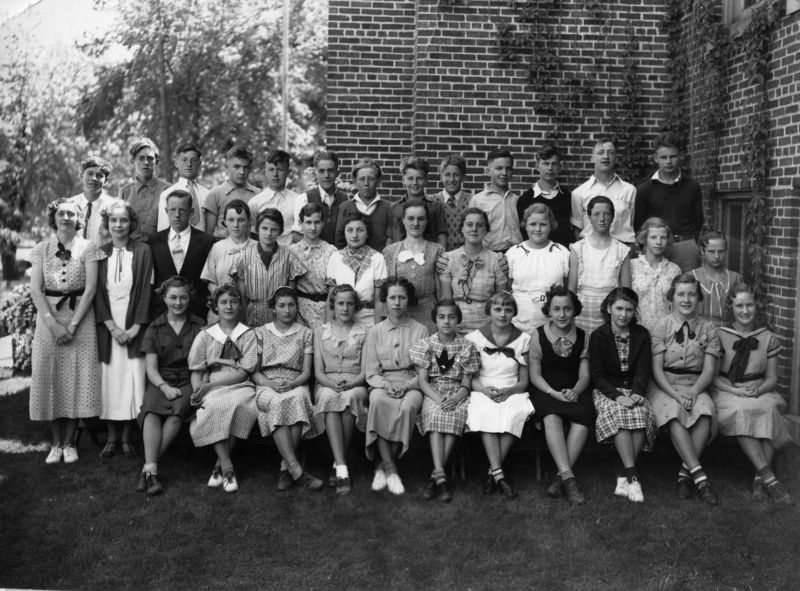 High school -- a time of nicknames and rivalries no matter when you were born. This photo, from a photo-album of the late 1930s, has some evidence on the front. That girl in the front row in white -- right in the middle -- has her eyes blacked-out with pencil (you can see it in the large version). On the back were, presumably, well-wishes from student's friends, names written in the hand of the signer. Underneath the photo, written on the page in the photo album, are a clearer picture of the students identities: "Bruno", "Giggling Gertie", "Ossie" -- and I think that's just the girls. Labels: 1930s, 1938, antique photo, high school, notes
Pfister Hotel Barber Shop Staff, 1960
Retro Keep Clean Sign
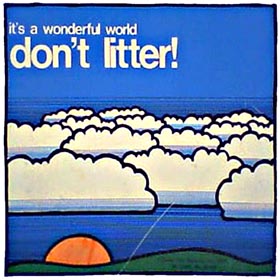 All the trash cans in a I94 rest area near Fergus Falls have this sign; I don't think I've seen it at any of the other Minnesota stops we've made. I've tried to see if the illustrator is credited, but no luck. Whoever came up with this sign did a very effective job - it's very eye-catching and it has some style. The use of thick lines and watercolory stripes has a very seventies feel. Using no-caps Helvetica is a little pretentious, but fits with the style of the image. I'm rather surprised it hasn't turned up elsewhere -- maybe off the freeway, somewhere. Labels: 2000s, illustration, rest area, trash can
4H IH Scout
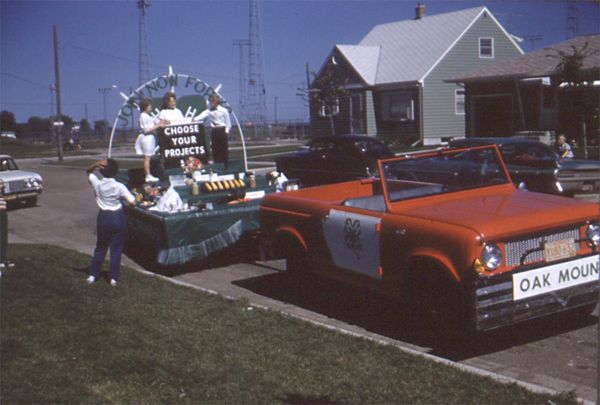 The float aside, that bright red truck is the focus here (also seen here, and here) The owner of this truck was a forward thinker: the shiny, new truck seen here was from the first year International Harvester made the Scout, its answer to the Jeep. At the time, tractor manufacturers weren't specifically tractor manufacturers: they made all kinds of motorized stuff beneficial to farmers. IH saw a need for a heavy-duty farm vehicle that Willis' Jeep was fulfilling, and came up with the Scout. Ford eventually followed with its Bronco, but the gas-conservation of the 70s mostly killed off these smaller versions of what we'd call an SUV. You may not know, but IH made the Scout until 1980: that's almost 20 years on the road. Labels: 1960s, 1961, 4h, automobilia, ih, international harvester, scout
Cranky, Cranky Kids
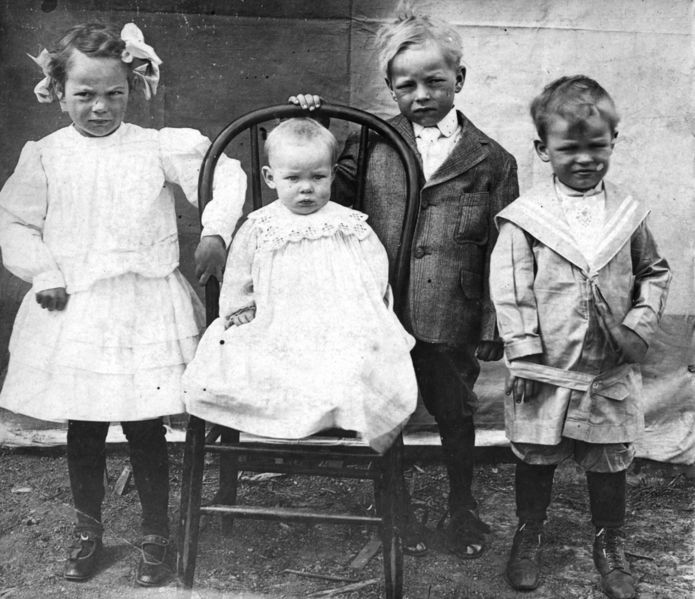 Oh, my -- I know kids hate to get dressed up, but the dress clothes of today pale in comparison to the kids of the early 1900s. That sailor suit on the right? It would cause a riot among modern kids. The photo appears to me to be from a travelling photographer; the ground is dirt and grass, the chair is simple (probably recruited from the nearest building), and the backdrop is simple. Despite the outdoors, the camera is of a vintage without a speedy shutter, resulting in some blurriness. It could, however, also be an attempt to emulate a more expensive photo studio by hanging a sheet over the washline and getting the kids dressed up to the tees. Either way, the kids weren't happy about it. see also: edwardian kids clothes * poor during Progressive era * progressivism and childrenLabels: 1900s, antique photo, fashion, kids
Three Gents in Snappy Hats
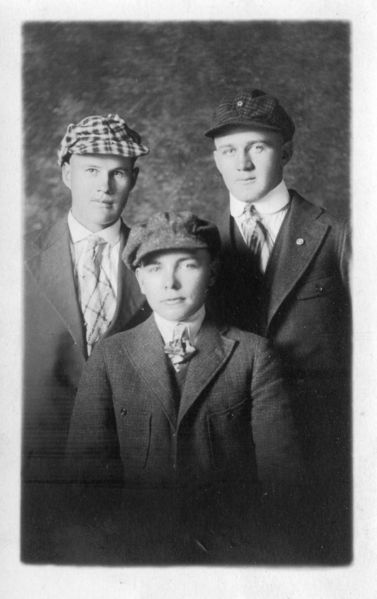 What's these guys' stories? Sometime in the 1910s, maybe twenties, three lads got together for a group shot -- and it must've been important that they be wearing hats. The style of hat is called a 'newsboy', 'Gatsby' hat, or driving cap, and was popular with the trendy kids of the early 20th century. The button-close breast pockets on the two gents on the right has a very military feel to it, and echoes the late 19th century. The lad on the left shops at a different tailor: sans vest, modern shirtcollar, his collar is lower, wider below the collar on the notched lapel, and is missing the breast pockets. Maybe he's older, and doesn't rely on Mom to do his clothes-shopping. Any which way, they're a sharp looking group of guys. Labels: 1910s, antique photo, clothing, men, suit
Riding the Red Comet
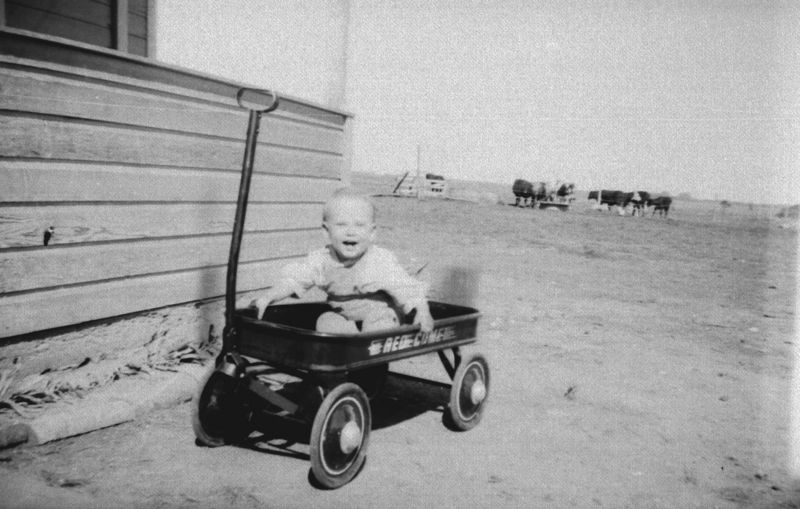 From an overexposed image, adjusted with Photoshop. This Red Comet, a fine steel wagon with rubber wheels, was probably a big gift for a kid back 'in the day' - no Toys R Us, and not a lot of money, meant not a lot of toys to go around. A wagon gave a kid transportation: load up the dog, fill it with rocks, drag around a sibling, all kinds of things beyond the scope of two little arms. Also, for a mom whose arms are already burdened with all kinds of carrying, a kid can be pulled along behind when working in the yard. Big rubber wheels and high clearance allowed for off-road travel. See also: radio flyer * how wagons are made * thoughts on red wagon originsLabels: 1930s, early 20th century farm photos, little red wagon, toy
J. D. Muldowney and Bro's Kitty Chorus
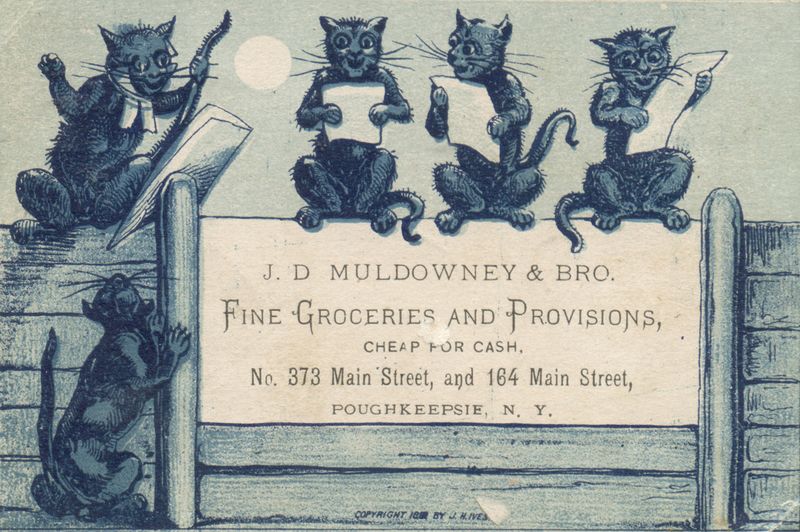 It's sad when something doesn't come up in Google whatsoever. J. D. Muldowney & Bro. - nothing. Neither address brings anything up. 164 Main looks like a parking lot now on Google Maps, but 373 could still be an old building. Not even the illustrator, J. H. Ives, shows up in search results. So, this little advertising card holds a bunch of mysterious info, guarded by a chorus of partially-anthropomorphized kitties. It's printed on a stiff card, not as thick as a postcard but thicker than paper, and it looks like it may have been gummed. Labels: 1880s, advertisement, cats, illustration
On Leave at Duffy's Gay Nineties
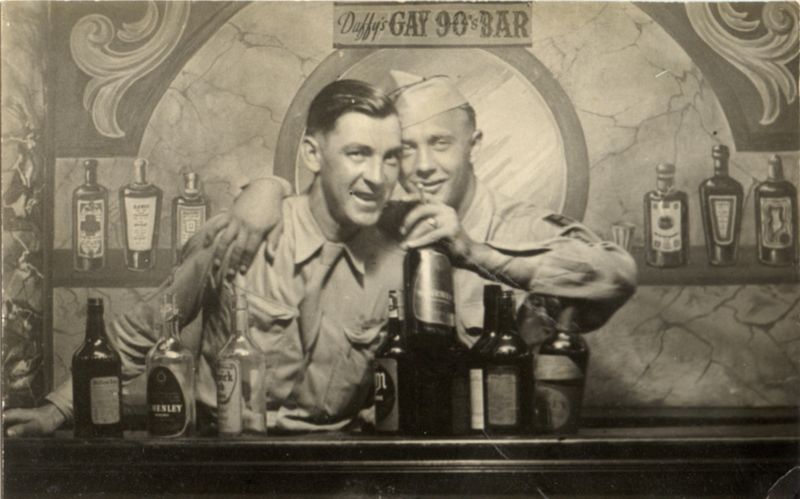 The back of this postcard says it was taken in Coney Island, so I doubt there was a real Duffy's Gay Nineties -- just a painted backdrop for fun-seekers to get a photo to mail back home. These two guys, on leave from the Army in 1946, seem to be enjoying themselves. The guy on the left has a single chevron, identifying him as private. The guy on the right, while blurry, still has a clear enough view of his unit patch: 1st Army. The guy on the right has some tell-tales in that hand, too (besides the bottle): on his ring-finger is a wedding ring, and between his fingers, a cigarette. The war was over, his best gal was waiting for him back home, and he got to live it up at Coney Island once in a while - he had no complaints. Labels: 1940s, 1946, 1st army, army, army uniform, coney island, first army, liquor bottle, new york, WWII
Massey-Harris '44
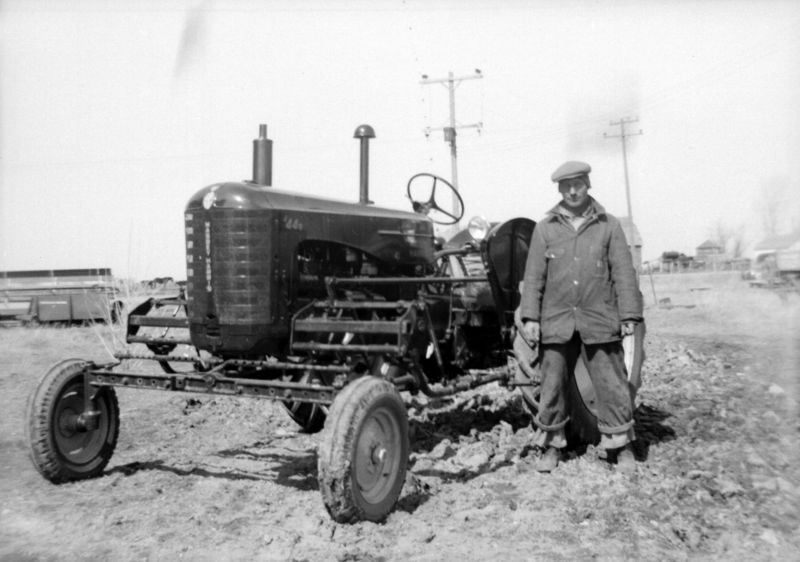 A Minnesota farmer and his new Massey Harris '44. The '44 was made for almost ten years through the late forties and early fifties, and from the pictures in this set I'd say this is on the later end of the timeline. The powerlines are one clue -- unless he's not at home in the picture, but there weren't power lines on the farm in earlier photos. The attachments on the sides, just above the front tires, are interesting -- I'm not sure what they're for. Weights? Some pictures of a '44 have a bucket on the front (and note the headlights moved to the fender, to avoid being knocked off), could it be that? Who knows, but he sure looks proud of his new tractor. see also: hard data * Massey [Harris|Ferguson] history * Massey-Harris Park, Toronto * MH in the 50s
Steampunk Joker
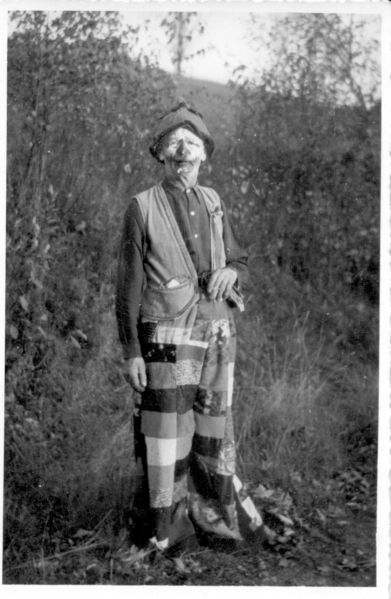 The new Joker The new Joker looks surprisingly like this artifact of the last century. This comedic entertainer certainly looks a bit past his prime -- although, he could just be worn out from his show. The makeup is smeared and worn off, and if you look really close you'll see a cigarette in his fingers. This was purchased from a travelling dealer here in Fargo, so I don't know where the funnyman is from. The hobo is usually an American style, so I doubt he's from abroad. Hopefully he stuck to clowning, and didn't run afoul of any batmen. Labels: antique photo, clown
Fly Northwest
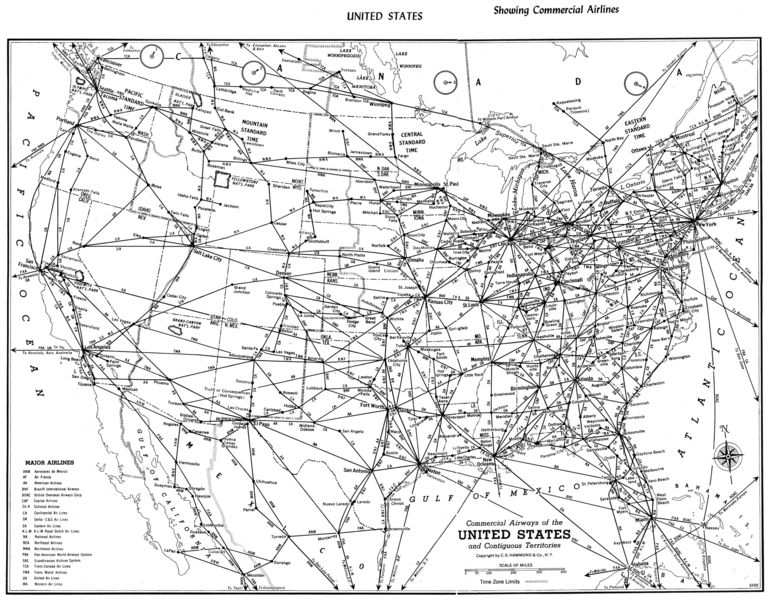 What's with all the lines? If you were planning on traveling by air in 1955, this is how you'd get there. Oh, the interstate system was still a year from even being thought of, so a trip from Fargo to Billings was better taken by air. Bus lines did exist, but, well, the busses of the time weren't much better than the yellow box kids ride to school in. That left rail, while more luxurious, was less flexible in destination. So, if you had the scratch, you could fly from Fargo to Jamestown on Northwest Airlines, something that takes a little over an hour at freeway speeds today, over long, straight Eisenhower-endorsed concrete. see also: Stewardess uniforms * Pacific Northwest Airlines * planes of the 50s * Fargo's Hector AirportLabels: 1950s, airlines, map
Scenic California
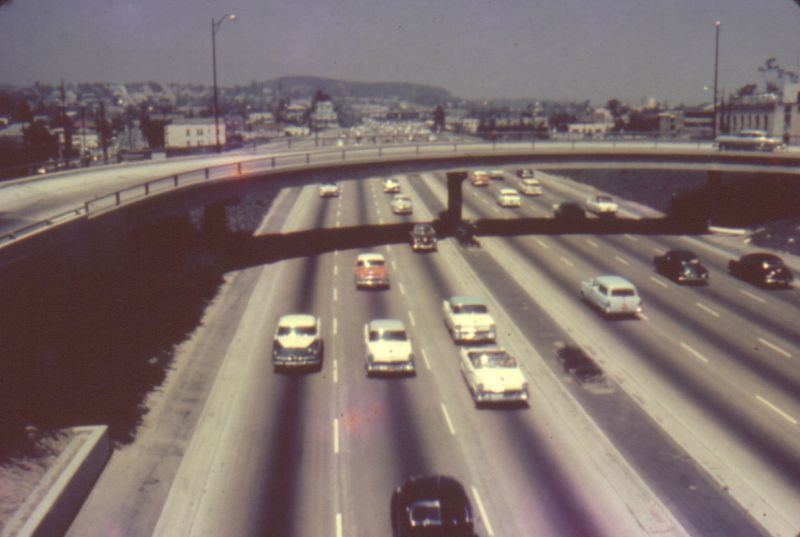 I know I've been picking on North Dakota for its scenic vastness, but is this so much better? Back in the 1960s, California was so proud of its freeway system that -- like Arizona with its Grand Canyon, South Dakota with its Mount Rushmore, New York with its Niagara Falls -- they released a set of collectible slides documenting the Los Angeles Freeway System. MARVEL at the expanses of concrete and pavement! SMELL the pollution wafting up from the vehicles! CRINGE IN TERROR at how close those two cars are in the third lane from the left! Oh, I kid -- unlike where I live, you can actually see some hills off towards the horizon. Between here and there, however, is a concrete jungle. I still prefer here. see also: pre-freeway map * California highways * more photos * just newer cars today * house stranded on CA highwayLabels: 1960s, california history, freeway, highway, vintage photo
Party at the Pfister, 1960
Lark movie theatre ad, 1970s.
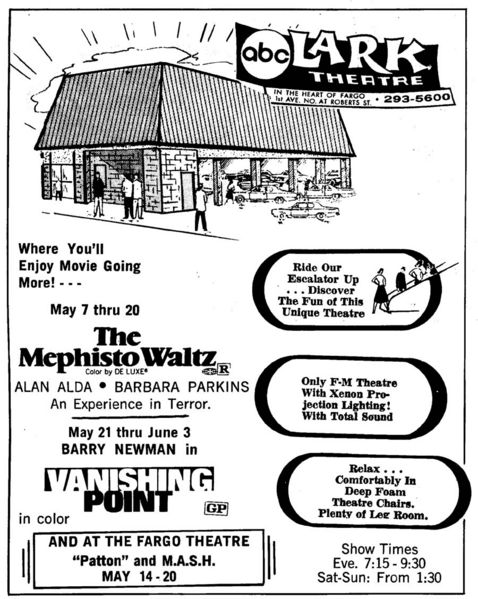 The Lark occupies the corner of Roberts Street and 1st Avenue in Fargo, one of the strange on-stilts buildings in Fargo designed to maximise parking space. The last time I was in the Lark was the Cinema Grill auction. The building had been vacant through the 1980s, but in the 90s a company reopened it as a dinner-movie-theatre. I'd seen one movie there, but that was it -- the films appeared to be VHS projections, as opposed to actual film, and the lights were up enough so you could read menus, which made the screen harder to see. The food-film experiment ended in the late 90s, and a Christian church of odd repute (when I was at the auction, the church's leader spent some time telling me how 9/11 was predicted in Scripture) held services in it, and I believe is still occupying the building. There had been rumours of that block being razed to build a sports arena -- a very bad idea in my mind -- but that's my guess as to why the Lark is still there., waiting for a developer to come along. The ad was from a Binford Guide. Labels: abc, advertisement, downtown fargo, lark, movie theatre, theatre
4H in Downtown Moorhead, Minnesota, 1961
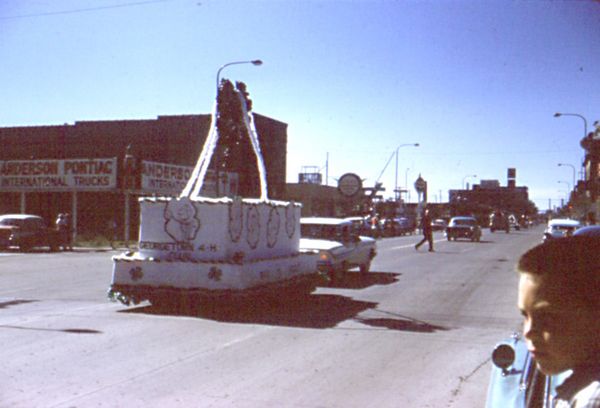 This photo was taken This photo was taken, looking west, down Center Avenue in Moorhead Minnesota, in 1961. These floats, all from 4Hers around Clay County, were on their way to the 4H Roundup in town. Much of what's seen here is still around, despite the flurry of Urban Renewal a few years later (most of that happened just off to the right of the photo) -- in the distance, that tall sign is the FM Hotel, now an office building; the sign now has the US Bank logo. That building in the foreground, with the Anderson Pontiac sign, and the building next to it, are still around, but I'm not sure what's occupying them now. see also: older Washington 4H parades * Cali 4H in the 20s * Moorhead Center Mall historyLabels: 1960s, 1961, 4h, minnesota, minnesota history, moorhead, parade
Armour Stockyards, West Fargo ND, 1938
|  |
|
|
